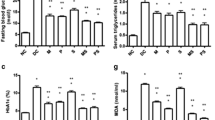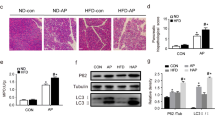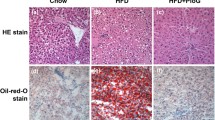Abstract
The metabolic syndrome (MetS) and pathologies associated with metabolic dysregulations a worldwide growing problem. Our previous study demonstrated that pioglitazone (PGZ) has beneficial effects on metabolic syndrome associated disturbances in the heart. However, mechanism mediating the molecular alterations of Ubiquitin proteasome system (UPS) and autophagy has not been investigated in rat pancreas with metabolic syndrome. For this reason, we first aimed to detect whether MetS effects on the expression of UPS (p97/VCP, SVIP, Ubiquitin) and autophagic (p62, LC3) proteins in rat pancreas. The second aim of the study was to find impact of pioglitazone on the expression of UPS and autophagic proteins in MetS rat pancreas. To answer these questions, metabolic syndrome induced rats were used as a model and treated with pioglitazone for 2 weeks. Pancreatic tissue injuries, fibrosis and lipid accumulation were evaluated histopathologically in control, MetS and MetS-PGZ groups. Apoptosis and cell proliferation of pancreatic islet cells were assessed in all groups. UPS and autophagic protein expressions of pancreas in all groups were detected by using immunohistochemistry, double-immunfluorescence and Western blotting. Compared with the controls, the rat fed with high sucrose exhibited signs of metabolic syndrome, such as higher body weight, insulin resistance, higher triglyceride level and hyperglycaemia. MetS rats showed pancreatic tissue degeneration, fibrosis and lipid accumulation when their pancreas were examined with Hematoxilen-eozin and Mallory trichrome staining. Metabolic, histopathologic parameters and cell proliferation showed greater improvement in MetS-PGZ rats and pioglitazone decreased apoptosis of islet cells. Moreover, SVIP, ubiquitin, LC3 and p62 expressions were significantly increased while only p97/VCP expression was significantly decreased in MetS-rat pancreas compared to control. PGZ treatment significantly decreased the MetS-induced increases in autophagy markers. Additionally, UPS and autophagy markers were found to colocalizated with insulin and glucagon. Colocalization ratio of UPS markers with insulin showed significant decrease in MetS rats and PGZ increased this ratio, whereas LC3-insulin colocalization displayed significant increase in MetS rats and PGZ reversed this effect. In conclusion, PGZ improved the pancreatic tissue degeneration by increasing the level of p97/VCP and decreasing autophagic proteins, SVIP and ubiquitin expressions in MetS-rats. Moreover, PGZ has an effect on the colocalization ratio of UPS and autophagy markers with insulin.









Similar content being viewed by others
References
Abella V et al (2014) Adipokines, metabolic syndrome and rheumatic diseases. J Immunol Res 2014:343746. https://doi.org/10.1155/2014/343746
Akcan G, Alimogullari E, Abu-Issa R, Cayli S (2020) Analysis of the developmental expression of small VCP-interacting protein and its interaction with steroidogenic acute regulatory protein in Leydig cells. Reprod Biol 20:88–96. https://doi.org/10.1016/j.repbio.2020.01.006
Alba M et al (2013) Sitagliptin and pioglitazone provide complementary effects on postprandial glucose and pancreatic islet cell function. Diabetes Obes Metab 15:1101–1110. https://doi.org/10.1111/dom.12145
Ballar P, Pabuccuoglu A, Kose FA (2011) Different p97/VCP complexes function in retrotranslocation step of mammalian ER-associated degradation (ERAD). Int J Biochem Cell Biol 43:613–621. https://doi.org/10.1016/j.biocel.2010.12.021
Ballar P, Zhong Y, Nagahama M, Tagaya M, Shen Y, Fang S (2007) Identification of SVIP as an endogenous inhibitor of endoplasmic reticulum-associated degradation. J Biol Chem 282:33908–33914. https://doi.org/10.1074/jbc.M704446200
Bilginoglu A, Selcuk MFT, Nakkas H, Turan B (2018) Pioglitazone provides beneficial effect in metabolic syndrome rats via affecting intracellular Na(+) dyshomeostasis. J Bioenerg Biomembr 50:437–445. https://doi.org/10.1007/s10863-018-9776-6
Butler AE, Janson J, Soeller WC, Butler PC (2003) Increased beta-cell apoptosis prevents adaptive increase in beta-cell mass in mouse model of type 2 diabetes: evidence for role of islet amyloid formation rather than direct action of amyloid. Diabetes 52:2304–2314. https://doi.org/10.2337/diabetes.52.9.2304
Catanzaro R, Cuffari B, Italia A, Marotta F (2016) Exploring the metabolic syndrome: nonalcoholic fatty pancreas disease. World J Gastroenterol 22:7660–7675. https://doi.org/10.3748/wjg.v22.i34.7660
Eckel RH, Grundy SM, Zimmet PZ (2005) The metabolic syndrome. Lancet 365:1415–1428. https://doi.org/10.1016/S0140-6736(05)66378-7
Eckel RH, Alberti KG, Grundy SM, Zimmet PZ (2010) The metabolic syndrome. Lancet 375:181–183. https://doi.org/10.1016/S0140-6736(09)61794-3
Galluzzi L, Pietrocola F, Levine B, Kroemer G (2014) Metabolic control of autophagy. Cell 159:1263–1276. https://doi.org/10.1016/j.cell.2014.11.006
Hartley T, Brumell J, Volchuk A (2009) Emerging roles for the ubiquitin-proteasome system and autophagy in pancreatic beta-cells. Am J Physiol Endocrinol Metab 296:E1-10. https://doi.org/10.1152/ajpendo.90538.2008
Hofmeister-Brix A, Lenzen S, Baltrusch S (2013) The ubiquitin-proteasome system regulates the stability and activity of the glucose sensor glucokinase in pancreatic beta-cells. Biochem J 456:173–184. https://doi.org/10.1042/BJ20130262
Hohn A, Konig J, Jung T (2016) Metabolic syndrome, redox state, and the proteasomal system. Antioxid Redox Signal 25:902–917. https://doi.org/10.1089/ars.2016.6815
Iizuka Y, Kim H, Izawa T, Sakurai K, Hirako S, Wada M, Matsumoto A (2016) Protective effects of fish oil and pioglitazone on pancreatic tissue in obese KK mice with type 2 diabetes. Prostaglandins Leukot Essent Fatty Acids 115:53–59. https://doi.org/10.1016/j.plefa.2016.10.007
Ishida H et al (2004) Pioglitazone improves insulin secretory capacity and prevents the loss of beta-cell mass in obese diabetic db/db mice: possible protection of beta cells from oxidative stress. Metabolism 53:488–494. https://doi.org/10.1016/j.metabol.2003.11.021
Kahn SE et al (2011) Effects of rosiglitazone, glyburide, and metformin on beta-cell function and insulin sensitivity in ADOPT. Diabetes 60:1552–1560. https://doi.org/10.2337/db10-1392
Kanda Y, Shimoda M, Hamamoto S, Tawaramoto K, Kawasaki F, Hashiramoto M, Nakashima K, Matsuki M, Kaku K (2010) Molecular mechanism by which pioglitazone preserves pancreatic beta-cells in obese diabetic mice: evidence for acute and chronic actions as a PPARgamma agonist. Am J Physiol Endocrinol Metab 298(2):E278-286. https://doi.org/10.1152/ajpendo.00388.2009
Kaniuk NA, Kiraly M, Bates H, Vranic M, Volchuk A, Brumell JH (2007) Ubiquitinated-protein aggregates form in pancreatic beta-cells during diabetes-induced oxidative stress and are regulated by autophagy. Diabetes 56:930–939. https://doi.org/10.2337/db06-1160
Kaufman RJ, Back SH, Song B, Han J, Hassler J (2010) The unfolded protein response is required to maintain the integrity of the endoplasmic reticulum, prevent oxidative stress, and preserve differentiation in cells. Diabetes Obes Metab 12:99–107. https://doi.org/10.1111/j.1463-1326.2010.01281.x
Kim KH, Lee MS (2014) Autophagy-a key player in cellular and body metabolism. Nat Rev Endocrinol 10:322–337. https://doi.org/10.1038/nrendo.2014.35
Kim WH, Lee JW, Suh YH, Hong SH, Choi JS, Lim JH, Song JH, Gao B, Jung MH (2005) Exposure to chronic high glucose induces beta-cell apoptosis through decreased interaction of glucokinase with mitochondria: downregulation of glucokinase in pancreatic beta-cells. Diabetes 54(9):2602–2611. https://doi.org/10.2337/diabetes.54.9.2602
Kim J, Lim YM, Lee MS (2018) The role of autophagy in systemic metabolism and human-type diabetes. Mol Cells 41:11–17. https://doi.org/10.14348/molcells.2018.2228
Kimura T et al (2015) Protective effects of pioglitazone and/or liraglutide on pancreatic beta-cells in db/db mice: comparison of their effects between in an early and advanced stage of diabetes. Mol Cell Endocrinol 400:78–89. https://doi.org/10.1016/j.mce.2014.11.018
Kirk-Ballard H, Kilroy G, Day BC, Wang ZQ, Ribnicky DM, Cefalu WT, Floyd ZE (2014) An ethanolic extract of Artemisia dracunculus L. regulates gene expression of ubiquitin-proteasome system enzymes in skeletal muscle: potential role in the treatment of sarcopenic obesity. Nutrition 30:S21–S25. https://doi.org/10.1016/j.nut.2014.02.027
Kobayashi T, Manno A, Kakizuka A (2007) Involvement of valosin-containing protein (VCP)/p97 in the formation and clearance of abnormal protein aggregates. Genes Cells 12:889–901. https://doi.org/10.1111/j.1365-2443.2007.01099.x
Kwon MJ et al (2019) The direct effect of lobeglitazone, a new thiazolidinedione, on pancreatic beta cells: a comparison with other thiazolidinediones. Diabetes Res Clin Pract 151:209–223. https://doi.org/10.1016/j.diabres.2019.04.006
Lim H et al (2018) A novel autophagy enhancer as a therapeutic agent against metabolic syndrome and diabetes. Nat Commun 9:1438. https://doi.org/10.1038/s41467-018-03939-w
Luciani DS, White SA, Widenmaier SB, Saran VV, Taghizadeh F, Hu X, Allard MF, Johnson JD (2013) Bcl-2 and Bcl-xL suppress glucose signaling in pancreatic beta-cells. Diabetes 62(1):170–182. https://doi.org/10.2337/db11-1464
Matsui J et al (2004) Pioglitazone reduces islet triglyceride content and restores impaired glucose-stimulated insulin secretion in heterozygous peroxisome proliferator-activated receptor-gamma-deficient mice on a high-fat diet. Diabetes 53:2844–2854. https://doi.org/10.2337/diabetes.53.11.2844
Menikdiwela KR et al (2020) Autophagy in metabolic syndrome: breaking the wheel by targeting the renin-angiotensin system. Cell Death Dis 11:87. https://doi.org/10.1038/s41419-020-2275-9
Nandi D, Tahiliani P, Kumar A, Chandu D (2006) The ubiquitin-proteasome system. J Biosci 31:137–155. https://doi.org/10.1007/BF02705243
Ozsoy AZ, Cayli S, Sahin C, Ocakli S, Sanci TO, Ilhan DB (2018) Altered expression of p97/Valosin containing protein and impaired autophagy in preeclamptic human placenta. Placenta 67:45–53. https://doi.org/10.1016/j.placenta.2018.05.013
Saitoh Y, Chun-ping C, Noma K, Ueno H, Mizuta M, Nakazato M (2008) Pioglitazone attenuates fatty acid-induced oxidative stress and apoptosis in pancreatic beta-cells. Diabetes Obes Metab 10(7):564–573. https://doi.org/10.1111/j.1463-1326.2007.00749.x
Sidiropoulos PI, Karvounaris SA, Boumpas DT (2008) Metabolic syndrome in rheumatic diseases: epidemiology, pathophysiology, and clinical implications. Arthritis Res Ther 10:207. https://doi.org/10.1186/ar2397
Srinivasan D, Ojo OO, Owolabi BO, Conlon JM, Flatt PR, Abdel-Wahab YHA (2015) The frog skin host-defense peptide CPF-SE1 improves glucose tolerance, insulin sensitivity and islet function and decreases plasma lipids in high-fat fed mice. Eur J Pharmacol 764:38–47. https://doi.org/10.1016/j.ejphar.2015.06.042
Tomita T (2016) Apoptosis in pancreatic beta-islet cells in Type 2 diabetes. Bosn J Basic Med Sci 16(3):162–179. https://doi.org/10.17305/bjbms.2016.919
Van Raalte DH et al (2014) The effect of alogliptin and pioglitazone combination therapy on various aspects of beta-cell function in patients with recent-onset type 2 diabetes. Eur J Endocrinol 170:565–574. https://doi.org/10.1530/EJE-13-0639
van den Boom J, Meyer H (2018) VCP/p97-mediated unfolding as a principle in protein homeostasis and signaling. Mol Cell 69:182–194. https://doi.org/10.1016/j.molcel.2017.10.028
Villacorta L, Schopfer FJ, Zhang J, Freeman BA, Chen YE (2009) PPARgamma and its ligands: therapeutic implications in cardiovascular disease. Clin Sci (lond) 116:205–218. https://doi.org/10.1042/CS20080195
Wang Y et al (2011) SVIP induces localization of p97/VCP to the plasma and lysosomal membranes and regulates autophagy. PLoS ONE 6:e24478. https://doi.org/10.1371/journal.pone.0024478
Wang AP et al (2013) Thiazolidinediones protect mouse pancreatic beta-cells directly from cytokine-induced cytotoxicity through PPARgamma-dependent mechanisms. Acta Diabetol 50:163–173. https://doi.org/10.1007/s00592-010-0239-8
Yki-Jarvinen H (2004) Thiazolidinediones. N Engl J Med 351:1106–1118. https://doi.org/10.1056/NEJMra041001
Zeender E, Maedler K, Bosco D, Berney T, Donath MY, Halban PA (2004) Pioglitazone and sodium salicylate protect human beta-cells against apoptosis and impaired function induced by glucose and interleukin-1beta. J Clin Endocrinol Metab 89(10):5059–5066. https://doi.org/10.1210/jc.2004-0446
Zhou X et al (2014) A model of metabolic syndrome and related diseases with intestinal endotoxemia in rats fed a high fat and high sucrose diet. PLoS ONE 9:e115148. https://doi.org/10.1371/journal.pone.0115148
Funding
This study was partially supported by Turkish Research Council (TUBITAK) with project number: 115S827.
Author information
Authors and Affiliations
Corresponding author
Ethics declarations
Conflict of interest
The authors declare that they have no conflict of interest.
Additional information
Publisher's Note
Springer Nature remains neutral with regard to jurisdictional claims in published maps and institutional affiliations.
Rights and permissions
About this article
Cite this article
Cayli, S., Alimogullari, E., Piskin, I. et al. Effect of pioglitazone on the expression of ubiquitin proteasome system and autophagic proteins in rat pancreas with metabolic syndrome. J Mol Histol 52, 929–942 (2021). https://doi.org/10.1007/s10735-021-10013-1
Received:
Accepted:
Published:
Issue Date:
DOI: https://doi.org/10.1007/s10735-021-10013-1




